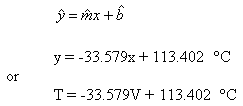Background:
You are to design a new multi-channel temperature data logging system for use in the hospital in which you are working. The specifications given for its design are:
- it is to be implemented around the Series 400 thermistor as a temperature probe,(such as YSI Series 400, or Thermometrics MA400)
- it must provide temperature data to within 0.1°C from -40 to 100°C
- it must have at least 6 independent channels each of which must be updated at least once every second
- the data must be accessible to IBM/PC or compatible computers, via a standard RS-232 interface
To convert the resistance, R, of the thermistors to a proportional voltage a constant current source is used. However, the problem that you immediately encounter is that the thermistors have an exponential response curve which makes direct digitization over the entire temperature range of interest difficult. You decide to linearize the voltage, as a function of temperature, prior to digitization by taking the double logarithm of the voltages measured across the thermistors, (the result of which is shown in Fig. 1).



Fig. 1: Plots of a) resistance, R, b) logarithm of the resistance, ln(R), and, c) double logarithm of the resistance, ln(ln(R)), as functions of temperature, T.
The process of taking the double logarithm of the analog signal is accomplished by the use of a pair of TL441AM logarithmic amplifiers (from Texas Instruments). The output voltage is then amplified and level shifted to give appropriate levels for the subsequent A/D converter. This being done, you collect the following data to see if your efforts have been justified:
Table 1: Thermistor Voltage and Temperature readings (after signal conditioning).| Temperature, T (°C) | -40 | -20 | 0 | 20 | 40 | 60 | 80 | 100 |
| Resistance, R (Ω) | 75773.0 | 21862.1 | 7352.90 | 2813.11 | 1199.72 | 560.34 | 282.64 | 152.78 |
| Output from log-amplifiers, (V) | 4.579 | 3.970 | 3.369 | 2.775 | 2.185 | 1.594 | 0.999 | 0.399 |
The Problem
- Find the equation of the best fit line (temperature as a function of voltage).
- Determine 95% confidence intervals for the slope and y-int.
- By looking at the results of (b) does it appear that the simple linear relation found in (a) is adequate to meet the specification of accuracy to within 0.1°C?




